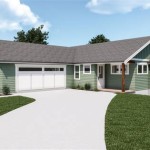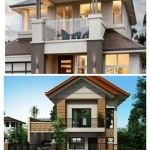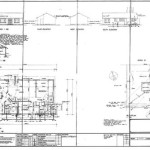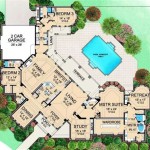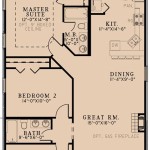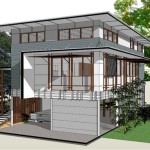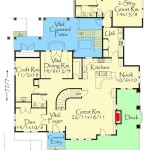Designing a 3,000 Square Foot House Floor Plan: Considerations and Best Practices
A 3,000 square foot house provides ample space for a family to live comfortably and entertain guests. Designing a floor plan for such a substantial home requires careful consideration of layout, functionality, and aesthetics. This article delves into key considerations and best practices for designing a 3,000 square foot house floor plan, providing a comprehensive guide for homeowners and architects.
1. Defining the Family's Needs and Lifestyle
Before commencing the design process, it is essential to understand the family's unique needs and lifestyle. This involves assessing the number of bedrooms, bathrooms, and living spaces required, as well as any specific preferences for features such as a home office, guest room, or dedicated play area. Additionally, consider the family's daily routines and habits to ensure the floor plan facilitates efficient flow and minimizes potential conflicts.
For example, a family with young children may prioritize a separate playroom or a spacious family room for shared activities. Families with remote workers may need dedicated home office spaces with adequate privacy and natural light. Understanding these nuances will guide the design process and ensure the floor plan meets the family's specific requirements.
2. Optimizing Space Utilization and Flow
Maximizing space utilization is crucial in a 3,000 square foot home to avoid wasted areas and ensure a sense of spaciousness. Efficient floor planning involves strategically allocating space to each room, maximizing natural light penetration, and creating smooth traffic flow between areas.
Open floor plans, which combine living, dining, and kitchen areas, are increasingly popular in modern homes. This approach creates a sense of openness and facilitates interaction between family members. However, it is essential to consider the potential for noise and privacy concerns when designing an open plan. Incorporating strategically placed walls or furniture can help define distinct zones within the space, providing privacy and visual separation when needed.
Efficient traffic flow is crucial for a functional home. Consider the primary pathways used by family members and guests, ensuring they are wide enough to accommodate movement and furniture placement. Avoid creating bottlenecks or dead ends that obstruct the flow of traffic.
3. Incorporating Natural Light and Outdoor Connections
Natural light significantly impacts the atmosphere and perceived spaciousness of a home. Maximizing window placement and size is paramount in a 3,000 square foot house. Large windows, strategically positioned to capture sunlight throughout the day, can dramatically enhance the interior environment. Consider utilizing skylights to introduce natural light into interior spaces, particularly those with limited exterior wall exposure.
Outdoor connections are integral to creating a seamless and inviting interior-exterior flow. Design the floor plan to encourage easy access to patios, balconies, or decks. Consider incorporating sliding glass doors or large windows that blur the boundaries between indoors and outdoors, bringing the beauty of nature inside.
4. Planning for Storage and Functionality
A 3,000 square foot house offers ample space for storage, but planning for it strategically is crucial to avoid clutter and maintain an organized environment. Design designated storage areas in each room, such as closets, pantries, and built-in shelves. Consider incorporating features like pull-out drawers, vertical storage, and under-stair storage solutions to maximize space efficiency.
Functionality is another key consideration. The layout should reflect daily routines and facilitate ease of movement and access to essential items. Design kitchens and bathrooms with efficient workspaces, ample counter space, and convenient storage solutions. In bedrooms, consider incorporating walk-in closets or built-in wardrobes to maximize functionality and minimize clutter.
5. Emphasizing Aesthetics and Personal Style
The design of a 3,000 square foot house goes beyond functionality to encompass aesthetics and personal style. Consider incorporating elements that reflect the homeowner's taste and preferences, creating a unique and inviting atmosphere. This might involve selecting specific finishes, materials, colors, and design details that evoke a desired mood and ambiance.
For example, a homeowner seeking a modern aesthetic may choose sleek lines, minimalistic details, and neutral color palettes. Conversely, a homeowner who prefers a traditional style may opt for ornate trim, architectural details, and rich, warm colors. The design should be a reflection of the homeowner's personality and create a space they feel comfortable and inspired in.

3 000 Square Foot House Plans Houseplans Blog Com

3 000 Square Foot House Plans Houseplans Blog Com

3 000 Square Foot House Plans Houseplans Blog Com

List Of 3000 To 3500 Sq Ft Modern Home Plan And Design With 4 Bedroom House Plans

Country Floor Plan 4 Bedrms Baths 3000 Sq Ft 141 1092

3000 Sq Ft Floor Plans Google Search Ranch House

Country House Plan With 4 Bedrooms And 3 5 Baths 7777

3 000 Square Foot House Plans Houseplans Blog Com

3 Bed 3000 Square Foot Contemporary Craftsman Home Plan With Covered Lanai 33248zr Architectural Designs House Plans

European Style House Plan 3 Beds 2 5 Baths 3001 Sq Ft 52 150 Plans One Story Ranch With S

